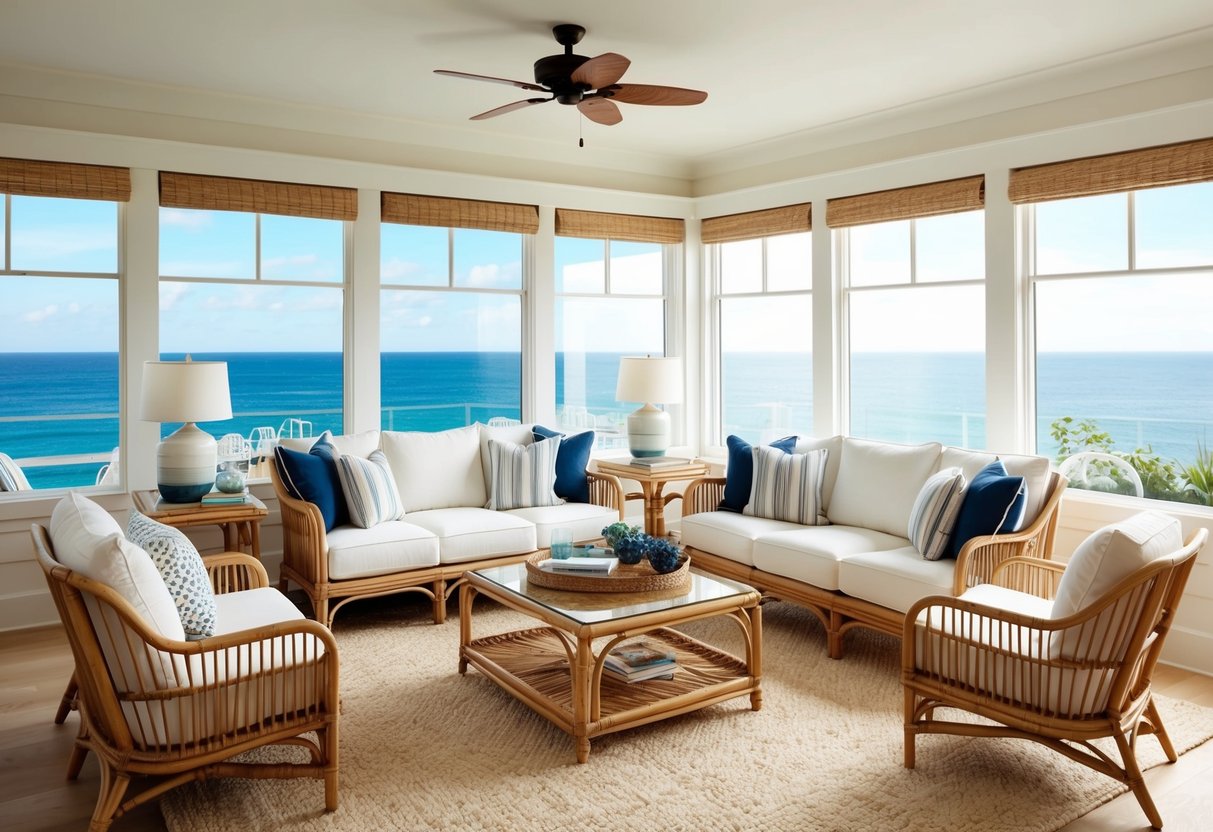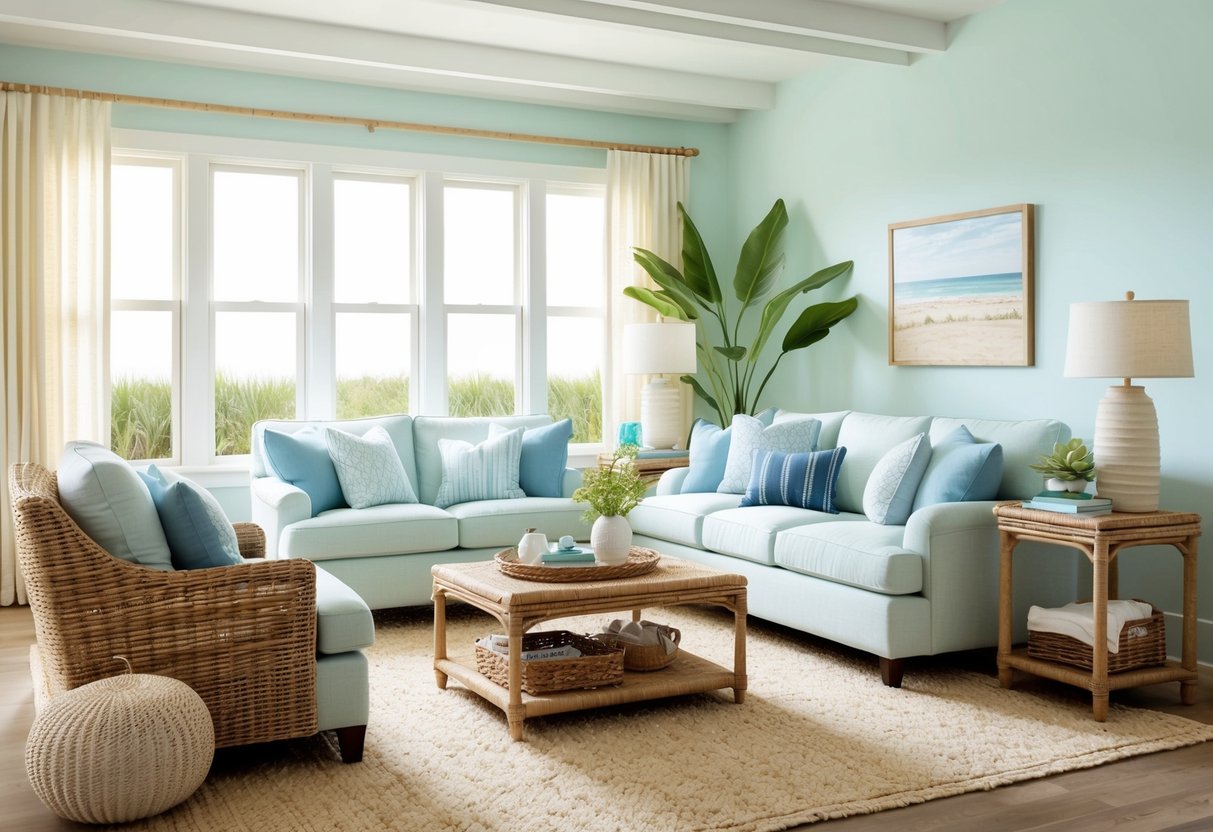
A relaxed, beach-inspired home starts with the right coastal interior design essentials. Key elements like light, airy colors, natural textures, and functional yet comfortable furniture create a calm space reminiscent of the seaside.
Using a palette of crisp whites, soft blues, sandy neutrals, and touches of seafoam green helps set the mood and brings a sense of openness that feels both fresh and timeless. Discover why many choose this style for its versatile blend of sophistication and comfort.
Many homeowners find that incorporating woven rattan or linen accents, clean-lined wood furnishings, and understated marine-inspired accessories are important steps in achieving a coastal look. Soft, layered textiles and abundant natural light further enhance the relaxed, welcoming atmosphere.
For a more specific guide to colors and materials that define coastal interior design, check this complete guide to coastal style for practical inspiration.
Coastal interiors can be tailored to modern tastes or traditional preferences. With the right combination of décor and thoughtful layout, it’s possible to create a tranquil, beachy retreat effect in any room.
Defining Coastal Interior Design

Coastal interior design emphasizes relaxed comfort, an abundance of natural light, and a connection to the shoreline through color, texture, and material. This style draws on soft palettes, organic elements, and minimalist influences to create spaces that feel open, airy, and inspired by the ocean.
Key Elements of Coastal Style
The foundation of coastal style centers on soft, tranquil tones like blues, seafoam greens, sandy beiges, and crisp whites. These colors evoke the calming presence of sky, sea, and sand, offering a serene backdrop for daily living.
Crisp white walls, pale floors, and gentle textiles visually expand rooms and reflect natural light. Natural materials are essential.
Rattan, jute, seagrass, and driftwood infuse spaces with texture and warmth. Light woods and woven accents introduce a tactile quality, often complemented by linen or cotton fabrics for an easygoing look.
Large windows, sheer curtains, and minimal window treatments ensure interiors remain bright and welcoming. Coastal décor is never overwhelming.
Accessories such as glass vases, handmade ceramics, and subtle seaside-inspired art provide personality without cluttering the space. Furniture pieces are chosen for comfort and durability, with plush couches and oversized chairs suited to relaxation.
Beach House Fundamentals
A beach house interior expresses sturdy, functional design that suits both relaxation and practicality. Hardwearing materials, like slipcovered sofas and resilient area rugs, are staple features.
These choices can withstand sand, sun, and dampness without sacrificing style or comfort. Layout in a beach house maximizes flow, often featuring open-plan living, dining, and kitchen spaces to foster togetherness and clear ocean views.
Storage solutions are cleverly integrated—built-in shelving, hidden cabinets, and baskets help minimize visual clutter while maintaining easy access to essentials. Textile choices prioritize lightness and durability.
Choose classic stripes, soft neutrals, or faded coastal patterns for cushions and throws. Subtle nautical touches—like rope details or weathered wood—offer a gentle nod to maritime influences without overwhelming the space or appearing themed.
More practical tips can be found in guides like Coastal Interior Design.
A Minimalist Approach
A minimalist approach to coastal interior design emphasizes simplicity, function, and a sense of openness. This means paring rooms down to essential furnishings and eliminating excess ornamentation.
Neutral colors and uncluttered layouts make spaces feel orderly and calm, reflecting the tranquility of the sea. Minimalism in the coastal context doesn’t remove warmth or character.
Instead, it celebrates carefully selected décor—each object has a purpose, such as a statement driftwood coffee table or a textural rug. Windows remain uncovered or use light-filtering treatments to strengthen the interplay of space and sunlight.
This approach suits anyone drawn to coastal style but prefers modern, streamlined interiors. It works especially well in smaller homes, condos, or apartments, where maximizing light and space creates a breezy, expansive effect.
Explore more on how to use a minimalist approach to coastal design and achieve a balanced, beach-inspired home.
Creating an Airy, Light-Filled Space
A coastal interior relies on a balance of natural light, strategic layouts, and thoughtful materials to foster an inviting, tranquil setting. Attention to these design details helps to achieve an open, fresh ambiance reminiscent of beachfront living.
Maximizing Natural Light
Allowing daylight to pour into rooms is a foundation of coastal design. Designers often prioritize large windows and glass doors to encourage unobstructed sunlight.
Arranging furniture to stay clear of windows and utilizing mirrors opposite key light sources can amplify the brightness throughout the home. Pale, reflective paint colors—such as crisp whites, soft creams, or muted blues—increase luminosity.
These hues bounce sunlight and discourage shadows, resulting in a more spacious, airy feel. Removing bulky window coverings and choosing minimal frames keeps outdoor views accessible.
To maximize this effect, coastal interiors embrace open shelving and light-toned flooring. The goal is to highlight the natural beauty that sunlight offers, freeing up spaces for effortless movement and visual clarity.
Learn more tips for brightening spaces from guides like the Ultimate Guide to Coastal Decor.
Clean Lines and Open Layouts
Simplicity is vital in coastal style. Clean architectural lines—seen in streamlined furniture, flat-panel cabinetry, and unadorned ceilings—help reduce visual noise.
Open layouts prioritize free circulation and let the eye travel uninterrupted from room to room. Many homeowners opt for low-profile sofas, benches, and minimalist tables, avoiding heavy ornamentation.
This uncluttered approach maintains the light, breezy character of a beach-inspired home. Displaying select decorative accents, such as glass vases or woven baskets, gives personality without crowding the space.
Often, designers encourage open-concept living and integrated dining areas, so natural light can reach deeper into the interior. This spatial approach supports connections between the outdoors and the heart of the home, reinforcing an easygoing, open atmosphere consistent with modern coastal interiors.
Window Treatments for a Breezy Feel
Lightweight fabrics are essential for window treatments in a coastal setting. Sheer linen or cotton drapery allows sunlight to filter softly, preserving privacy while keeping the room bright.
Neutral and sandy shades complement the palette and add to the relaxed feeling. Simple, unobtrusive hardware—like slim rods or concealed tracks—keeps the focus on both the view and the architecture.
Roman shades or woven bamboo blinds provide structure without heavy layers. These options are easy to adjust throughout the day, letting homeowners respond to changing light conditions.
For an authentic coastal ambiance, it’s best to avoid ornate valances or blackout curtains. Instead, layering translucent materials delivers both function and an airy, inviting look that enhances the architectural lines and leafy outlooks commonly featured in elegant coastal chic decorating.